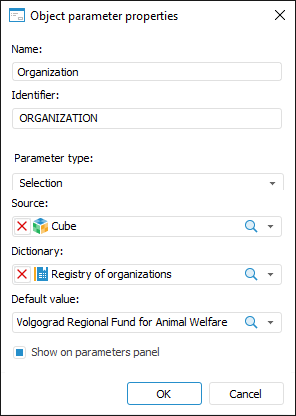To open the Calculation Algorithm Parameters dialog box, click the ![]() Setup button in the Calculation Parameters group on the Calculation ribbon tab.
Setup button in the Calculation Parameters group on the Calculation ribbon tab.
Algorithm parameters enable the user to dynamically control linked block calculation and algorithm calculation period.
Calculation algorithm parameters can be added on the Parameters tab in the Calculation Algorithm Parameters dialog box:

To set parameter values that will be used on algorithm calculation, use the parameters panel. The order of parameters display on this panel matches with the order of parameters on the Parameters tab in the Calculation Algorithm Parameters dialog box.
If a calculation algorithm is located in a container or business application, the Parameters tab displays the Use Repository Objects checkbox. The checkbox is deselected by default, and when adding a parameter, one can use as its properties only the repository objects contained in the corresponding container or business application. To use any repository objects as parameter properties, select the Use Repository Objects checkbox.
A parameter can be set up in the Object Parameter Properties dialog box:

Specify:
Name. A parameter name should be meaningful and explain parameter functionality. The property is mandatory.
Identifier. A parameter identifier should be unique. An identifier should consist of Latin letters. It may contain numbers and underscore characters, and must start with a letter. The property is mandatory.
Parameter Type. Select parameter type:
Selection. Default. Dictionary selection is used as a parameter value.
Hierarchy. Dictionary alternative hierarchy is used as a parameter value.
String. A character string is used as a parameter value.
Integer. An integer number is used as parameter value.
Real. A real number is used as a parameter value.
Date. A date is used as a parameter value.
NOTE. Parameter type can be changed only on creating a parameter.
Source. If required, select the cube containing controlling or controlled dimensions on the Controlling Dimensions page in the corresponding cube wizard. The box is available only for the parameters of the Selection and Hierarchy types.
NOTE. After selecting the cube the Dictionary drop-down list will contain only the dictionaries included in the selected cube.
If the dictionary is not displayed in the controlling or controlled dimensions list but is included in the cube, dictionary selection or alternative hierarchy is used as parameters values. This dictionary can be selected in the Dictionary drop-down list without specifying the cube in the Source drop-down list.
If the dictionary is displayed in the controlling or controlled dimensions list, observe the general order of adding calculation algorithm parameters to ensure correct displaying of dictionary element set depending on the configured management type:
Parameters that manage cube parameters.
Parameters based on cube controlling dimensions. Element selection should be set for each dimension.
Parameters based on cube controlled dimensions. Elements of controlled dimensions depend on the controlling dimension element selection.
Dictionary. Select the dictionary, to which the parameter is linked. Dictionary selection or alternative hierarchy will be used as parameter values. The box is available only for the parameters of the Selection and Hierarchy types, and it is mandatory for them.
NOTE. If a cube is selected in the Source drop-down list, the Dictionary drop-down list displays only the dictionaries contained in the selected cube.
Default Value. Select the default parameter value in the drop-down list or enter it by means of keyboard.
NOTE. If a link with cube parameter is set for the parameter on the parameters panel, parameter's selection will be reset on the parameters panel if the default parameter value changes.
Show on Parameters Panel. Deselect the checkbox to hide the parameter on the parameters panel. The default parameter value will be used during algorithm calculation. The checkbox is selected by default, parameter values can be changed on the parameters panel before algorithm calculation.
See also:
Getting Started with the Calculation Algorithms Extension in the Web Application | Adding and Setting Up Parameters